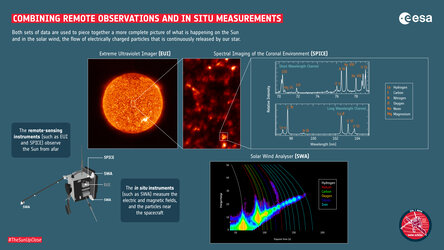Accept all cookies Accept only essential cookies See our Cookie Notice

About ESA
The European Space Agency (ESA) is Europe’s gateway to space. Its mission is to shape the development of Europe’s space capability and ensure that investment in space continues to deliver benefits to the citizens of Europe and the world.
Highlights
ESA - United space in Europe
This is ESA ESA facts Member States & Cooperating States Funding Director General Top management For Member State Delegations European vision European Space Policy ESA & EU Space Councils Responsibility & Sustainability Annual Report Calendar of meetings Corporate newsEstablishments & sites
ESA Headquarters ESA ESTEC ESA ESOC ESA ESRIN ESA EAC ESA ESAC Europe's Spaceport ESA ESEC ESA ECSAT Brussels Office Washington OfficeWorking with ESA
Business with ESA ESA Commercialisation Gateway Law at ESA Careers Cyber resilience at ESA IT at ESA Newsroom Partnerships Merchandising Licence Education Open Space Innovation Platform Integrity and Reporting Administrative Tribunal Health and SafetyMore about ESA
History ESA Historical Archives Exhibitions Publications Art & Culture ESA Merchandise Kids Diversity ESA Brand CentreLatest
Space in Member States
Find out more about space activities in our 23 Member States, and understand how ESA works together with their national agencies, institutions and organisations.
Science & Exploration
Exploring our Solar System and unlocking the secrets of the Universe
Go to topicAstronauts
Missions
Juice Euclid Webb Solar Orbiter BepiColombo Gaia ExoMars Cheops Exoplanet missions More missionsActivities
International Space Station Orion service module Gateway Concordia Caves & Pangaea BenefitsLatest
Space Safety
Protecting life and infrastructure on Earth and in orbit
Go to topicAsteroids
Asteroids and Planetary Defence Asteroid danger explained Flyeye telescope: asteroid detection Hera mission: asteroid deflection Near-Earth Object Coordination CentreSpace junk
About space debris Space debris by the numbers Space Environment Report In space refuelling, refurbishing and removingSafety from space
Clean Space ecodesign Zero Debris Technologies Space for Earth Supporting Sustainable DevelopmentLatest
Applications
Using space to benefit citizens and meet future challenges on Earth
Go to topicObserving the Earth
Observing the Earth Future EO Copernicus Meteorology Space for our climate Satellite missionsCommercialisation
ESA Commercialisation Gateway Open Space Innovation Platform Business Incubation ESA Space SolutionsLatest
Enabling & Support
Making space accessible and developing the technologies for the future
Go to topicBuilding missions
Space Engineering and Technology Test centre Laboratories Concurrent Design Facility Preparing for the future Shaping the Future Discovery and Preparation Advanced Concepts TeamSpace transportation
Space Transportation Ariane Vega Space Rider Future space transportation Boost! Europe's Spaceport Launches from Europe's Spaceport from 2012Latest

First measurements from the Solar Wind Analyser
Thank you for liking
You have already liked this page, you can only like it once!
The Solar Wind Plasma Analyser (SWA) on ESA’s Solar Orbiter samples the solar wind around the spacecraft. This coloured plot shows the first scientific measurements made by its SWA Heavy Ion Sensor (HIS). The data was taken on 11 May 2020.
Ions are electrically charged atoms. They make up most of the mass of the solar wind. Although ions of carbon, oxygen, silicon, iron, etc are less abundant, they carry crucial information about the heating mechanism in the Sun’s outer atmosphere and the way in which the solar wind is accelerated into space. Their detection and analysis is therefore critical for understanding the connection between the solar corona and the solar wind/heliosphere.
The sensor is able to determine, among other characteristics, the ratio of an ion’s energy to its charge, and its speed across a known distance within the instrument, as given by the time it takes to cross that distance. This data has then been plotted on the graph along with the theoretical curves of expected ions, which are colour-coded according to the ions in the legend. The coloured patches represent the number of particles (yellow means lots, blue means few) entering the instrument with each characteristic and thus indicate their relative abundance in the solar wind passing the spacecraft.
HIS is one of three sensors that make up the Solar Wind Analyser (SWA) instrument suite on Solar Orbiter. The ‘Electron Analyser system’ (EAS) and the Proton/Alpha particle Sensor (PAS) make up the other two components.
“A number of the properties of the heavy ion populations are unique in that they undergo relatively little evolution during transport of the solar wind from the Sun to the spacecraft,” says Prof Christopher J. Owen (UCL Mullard Space Science Laboratory), Principal Investigator for the SWA. “They thus remain an excellent diagnostic of the nature of those ions in the corona and provide critical ‘finger-prints’ of the physical processes that drive the formation of the solar wind.”
Solar Orbiter is a space mission of international collaboration between ESA and NASA.
-
CREDIT
ESA & NASA/Solar Orbiter/SWA Team -
LICENCE
ESA Standard Licence

Solar wind through a comet’s tail

Tasting a comet’s tail

Combining remote-sensing and in situ measurements

Solar Orbiter first images and measurements















 Germany
Germany
 Austria
Austria
 Belgium
Belgium
 Denmark
Denmark
 Spain
Spain
 Estonia
Estonia
 Finland
Finland
 France
France
 Greece
Greece
 Hungary
Hungary
 Ireland
Ireland
 Italy
Italy
 Luxembourg
Luxembourg
 Norway
Norway
 The Netherlands
The Netherlands
 Poland
Poland
 Portugal
Portugal
 Czechia
Czechia
 Romania
Romania
 United Kingdom
United Kingdom
 Slovenia
Slovenia
 Sweden
Sweden
 Switzerland
Switzerland
























